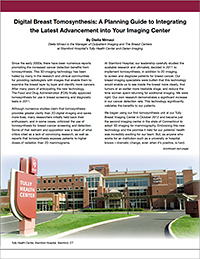
Editor's Note: This is the last installment of a five-part series adapted from the author's paper "Digital Breast Tomosynthesis: A Planning Guide to Implementing the Latest Advancement into Your Imaging Center." Links to parts the previous installments, in addition to the full paper, can be found at the bottom of this post.
Background:
We began using digital breast tomosynthesis in October 2012 - just the the second imaging center at the time to adopt 3D imaging for mammography in the entire state of Connecticut. As anyone who works for an institution like a university or hospital knows - dramatic change, even when it's positive, is hard. We faced a variety of of challenges integrating this technology into our facility and our workflow and feel the lessons we learned can benefit others as they consider implementing digital breast tomosynthesis into their hospital or practice.
Seeing the Payoff
After some fits and starts, our success with digital breast tomosynthesis was undeniable - and we had the data to prove it.
When we showed the numbers on patient satisfaction, the adoption rate by our radiologists and technologists, and the reduction in false positives, false negatives, and call-backs for reimaging - hospital leadership was instantly sold. They were more than happy to accommodate our request to meet the incredible surge in demand for 3D screening and approved funding for an additional tomosynthesis room for Tully and a new tomosynthesis room at our other busy outpatient imaging center in Darien.
All our hard work and sacrifices paid off just as we had hoped. In fiscal year 2013, with 3 tomosynthesis units in operation across the Stamford Hospital system, we performed 14,000 screening mammograms. In the first 6 months of 2014 alone, we had already surpassed the number with 16,000 screening mammograms performed. In addition, patient complaints have fallen dramatically and our Press Ganey® scores increased.
As we continue to engage women at health expos and through our community outreach programs, the demand for 3D mammography only continues to expand. in fact, it has grown so much that the hospital is now close to approving a mobile tomosynthesis unit in order to serve even more women throughout Fairfield County.
With more and more research proving the benefits of digital breast tomosynthesis, it's highly likely you're not considering whether to implement it, but when. I hope that this account of our experiences at Stamford Hospital helps you prepare for a smooth transition.
To help you on your journey, here are a few tips to keep in mind from someone whose been in your shoes:
- Plan for resistance and plan for change. This will be a journey with some bumps along the road that will require fine-tuning and adjustment to both people and processes.
- Confirm that your current PACS system is compatible with the technology. Certain PACS versions are not able to integrate correctly, resulting in images that are inverted, degraded, and facing the wrong direction.
- Submit your QA/QC within 6 month of your initial approval. This is necessary to maintain your FDA accreditation.
- Ensure that you are using tomosynthesis compatible skin markers for marking moles, nipples, scars, palpable masses and non-palpable areas of pain or concern. Keep in mind that due to the heightened sensitivity of 3D imaging, dense materials can cause an artifact through the tomosynthesis slices that may obscure or overshadow underlying structures. The lower the density, the better the marker for this technology.
- Rest easy in the knowledge that whatever you go through, it will all be worth it in the end for both you and your patients.
Read Parts 1, 2, 3, & 4:
How We Implemented Digital Breast Tomosynthesis into Our Busy Imaging Center and Lived to Tell About It - Part 1 - The Journey Begins, then Falters
How We Implemented Digital Breast Tomosynthesis into Our Busy Imaging Center and Lived to Tell About It - Part 2 - A Champion (and Dramatic Workflow Changes) Emerge
How We Implemented Digital Breast Tomosynthesis into Our Busy Imaging Center and Lived to Tell About It - Part 3 - Stress Levels Go Through the Roof
How We Implemented Digital Breast Tomosynthesis into Our Busy Imaging Center and Lived to Tell About It - Part 4 - The Straw That Broke the Camel's Back
Click on the thumbnail below to read the full paper:

Diella Mrnaci

